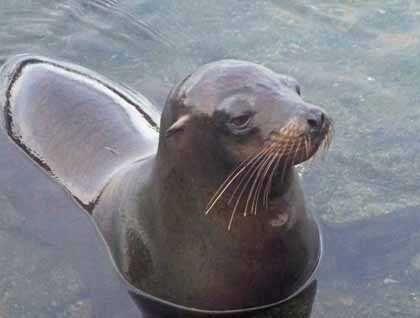We came from the west of Galapagos last night. Motoring for around 11 hours, it is the longest trip of our week. Finally we arrived at James Island, known in Spanish as Santiago or San Salvador. It is the third biggest of the 17 major islands forming this unique archipelago. The place we are visiting this morning is Espumilla Beach. Have you seen white foam formed by wave actions against the coast? Well, that is the origin of this name, as Espumilla is that foam. Here you see a lot of it because of the constant motion of the ocean.
We landed at 7:00 a.m. and had a nice walk around this magnificent place. The vegetation here is very tall, and you find a wide diversity of plants. It is because the island is older, about 2.5 million years old, and consequently, more soil, moisture and weathering is present here. Some of the trees are very old and it makes this place a good house for land birds such as mockingbirds, finches, anies, warblers, flight catchers, hawks, and more. Behind the beach where we landed is a brackish water lagoon. Millions of fiddler and ghost crabs were coming out of their holes to feed on smaller organisms, but up above the food chain was a flamingo, some whimbrels and pintails swimming in this water, and plenty of shrimps and small mollusks.
Kayaking was delightful here. Some our more intrepid travelers went to explore the coast of Buccaneer Cove, a refugee for pirates and whalers around two centuries ago. Also Darwin, the famous geologist and naturalist that visited Galapagos in 1835 spent nine days in this place, collecting specimens that later on formulated in his mind the ideas of natural selection set in his famous book “The Origin of Species” published in 1859. So there is a lot of human history in this particular place, and our avid guests enjoy all these stories.
James is also our adopted island, as a few years ago, Lindblad Expeditions, with the support of all our travelers, helped to finance the eradication of feral goats that existed by thousands in this island, and were causing the ruin of endemic species like the giant tortoises. Now we are very happy, all introduced species were removed successfully from here.
In the afternoon we moved to Puerto Egas, an incredible visitor site. We walked along the coast to enjoy one more time all of the unique flora and fauna that decorates the islands. The path took us inside the island, where finches and yellow warblers were feeding on locust and caterpillars, then out on shoreline the grottos were an excellent place to enjoy a colony of fur sea lions, paying in the turquoise blue water of these pools. Several migratory birds were seen along the coast: plovers, sand pipers, whimbrels, and herons. Our bird watchers were very happy.
Sea lions playing, iguanas basking, and our travelers having fun was the last memory I have of this journey. We came back to our ship, the sunset painted the sky of reddish colors. At night we had dinner on the sundeck, under of a clear sky filled with stars.







